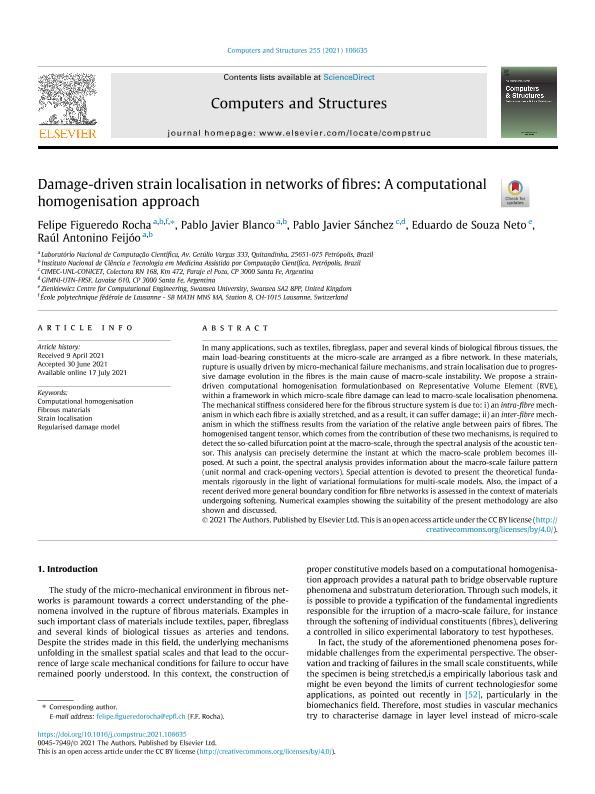Mostrar el registro sencillo del ítem
dc.contributor.author
Rocha, Felipe Figueredo
dc.contributor.author
Blanco, Pablo Javier

dc.contributor.author
Sánchez, Pablo Javier

dc.contributor.author
De Souza Neto, Eduardo Alberto

dc.contributor.author
Feijóo, Raúl Antonino

dc.date.available
2022-12-23T02:11:43Z
dc.date.issued
2021-10
dc.identifier.citation
Rocha, Felipe Figueredo; Blanco, Pablo Javier; Sánchez, Pablo Javier; De Souza Neto, Eduardo Alberto; Feijóo, Raúl Antonino; Damage-driven strain localisation in networks of fibres: A computational homogenisation approach; Pergamon-Elsevier Science Ltd; Computers & Structures; 255; 106635; 10-2021; 1-28
dc.identifier.issn
0045-7949
dc.identifier.uri
http://hdl.handle.net/11336/182278
dc.description.abstract
In many applications, such as textiles, fibreglass, paper and several kinds of biological fibrous tissues, the main load-bearing constituents at the micro-scale are arranged as a fibre network. In these materials, rupture is usually driven by micro-mechanical failure mechanisms, and strain localisation due to progressive damage evolution in the fibres is the main cause of macro-scale instability. We propose a strain-driven computational homogenisation formulationbased on Representative Volume Element (RVE), within a framework in which micro-scale fibre damage can lead to macro-scale localisation phenomena. The mechanical stiffness considered here for the fibrous structure system is due to: i) an intra-fibre mechanism in which each fibre is axially stretched, and as a result, it can suffer damage; ii) an inter-fibre mechanism in which the stiffness results from the variation of the relative angle between pairs of fibres. The homogenised tangent tensor, which comes from the contribution of these two mechanisms, is required to detect the so-called bifurcation point at the macro-scale, through the spectral analysis of the acoustic tensor. This analysis can precisely determine the instant at which the macro-scale problem becomes ill-posed. At such a point, the spectral analysis provides information about the macro-scale failure pattern (unit normal and crack-opening vectors). Special attention is devoted to present the theoretical fundamentals rigorously in the light of variational formulations for multi-scale models. Also, the impact of a recent derived more general boundary condition for fibre networks is assessed in the context of materials undergoing softening. Numerical examples showing the suitability of the present methodology are also shown and discussed.
dc.format
application/pdf
dc.language.iso
eng
dc.publisher
Pergamon-Elsevier Science Ltd

dc.rights
info:eu-repo/semantics/openAccess
dc.rights.uri
https://creativecommons.org/licenses/by-nc-sa/2.5/ar/
dc.subject
COMPUTATIONAL HOMOGENISATION
dc.subject
FIBROUS MATERIALS
dc.subject
REGULARISED DAMAGE MODEL
dc.subject
STRAIN LOCALISATION
dc.subject.classification
Mecánica Aplicada

dc.subject.classification
Ingeniería Mecánica

dc.subject.classification
INGENIERÍAS Y TECNOLOGÍAS

dc.title
Damage-driven strain localisation in networks of fibres: A computational homogenisation approach
dc.type
info:eu-repo/semantics/article
dc.type
info:ar-repo/semantics/artículo
dc.type
info:eu-repo/semantics/publishedVersion
dc.date.updated
2022-09-21T11:13:52Z
dc.journal.volume
255
dc.journal.number
106635
dc.journal.pagination
1-28
dc.journal.pais
Estados Unidos

dc.journal.ciudad
Amsterdam
dc.description.fil
Fil: Rocha, Felipe Figueredo. Instituto Nacional de Ciência E Tecnologia Em Medicina Assistida Por Computação Científica; Brasil. Ecole Polytechnique Fédérale de Lausanne; Suiza. Consejo Nacional de Investigaciones Científicas y Técnicas. Centro Científico Tecnológico Conicet - Santa Fe. Centro de Investigaciones en Métodos Computacionales. Universidad Nacional del Litoral. Centro de Investigaciones en Métodos Computacionales; Argentina
dc.description.fil
Fil: Blanco, Pablo Javier. Instituto Nacional de Ciência E Tecnologia Em Medicina Assistida Por Computação Científica; Brasil. Ecole Polytechnique Fédérale de Lausanne; Suiza
dc.description.fil
Fil: Sánchez, Pablo Javier. Consejo Nacional de Investigaciones Científicas y Técnicas. Centro Científico Tecnológico Conicet - Santa Fe. Centro de Investigaciones en Métodos Computacionales. Universidad Nacional del Litoral. Centro de Investigaciones en Métodos Computacionales; Argentina
dc.description.fil
Fil: De Souza Neto, Eduardo Alberto. Swansea University; Reino Unido
dc.description.fil
Fil: Feijóo, Raúl Antonino. Ecole Polytechnique Fédérale de Lausanne; Suiza. Instituto Nacional de Ciência E Tecnologia Em Medicina Assistida Por Computação Científica; Brasil
dc.journal.title
Computers & Structures

dc.relation.alternativeid
info:eu-repo/semantics/altIdentifier/doi/http://dx.doi.org/10.1016/j.compstruc.2021.106635
dc.relation.alternativeid
info:eu-repo/semantics/altIdentifier/url/https://www.sciencedirect.com/science/article/pii/S0045794921001577
Archivos asociados
